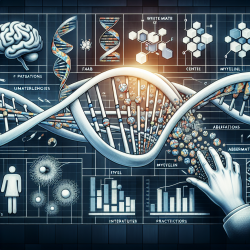The quest to unravel the complexities of autism spectrum disorders (ASD) continues to be a significant focus within the scientific and educational communities. Recent research has shed light on potential genetic contributors, including heterozygous mutations in the FA2H gene. This blog post aims to provide practitioners with insights into these findings and encourage further exploration into their implications for ASD.
The Significance of FA2H in Myelin Synthesis
The FA2H gene encodes fatty acid 2-hydroxylase, an enzyme integral to the production of myelin sheaths that insulate nerve fibers. Proper myelination is crucial for efficient neural communication. While homozygous mutations in FA2H are known to cause severe neurodegenerative disorders, this study explores the impact of heterozygous mutations as potential risk factors for ASD.
Research Findings
The study involved genotyping 1256 patients with ASD and sequencing an additional 186 subjects alongside 353 controls. The researchers identified a rare heterozygous deletion within 16q22.3-q23.1, including the FA2H gene, in two siblings with autism and severe cognitive impairment. Additionally, two rare non-synonymous mutations (R113W and R113Q) were reported.
- Deletion Findings: The deletion was associated with symptoms of autism and white matter lesions observed through MRI scans.
- Mutation Analysis: Although predictive models suggested the R113W mutation could be deleterious, it did not significantly affect FA2H enzymatic activity in vitro.
Implications for Practitioners
While the study concludes that heterozygous FA2H mutations do not play a major role in ASD etiology, it highlights the importance of examining other genes related to myelin synthesis. Practitioners should consider these findings as part of a broader genetic landscape that includes multiple interacting factors contributing to ASD.
- Encouraging Further Research: Practitioners are encouraged to explore additional genetic markers and environmental factors that may influence myelination and connectivity in ASD.
- Integrating Insights into Practice: Understanding the potential role of non-neuronal elements like myelin can inform more comprehensive approaches to diagnosis and intervention strategies.
The Broader Context
This research contributes to a growing body of evidence suggesting that abnormalities in white matter development may underlie some ASD symptoms. By advancing our understanding of how genetic variations affect neural connectivity, we can better address the diverse needs of individuals with ASD.
For practitioners seeking to deepen their knowledge, this study offers a valuable perspective on the interplay between genetics and neurodevelopmental disorders. As we continue to uncover new insights, collaboration between researchers and educators will be crucial in translating these findings into effective educational practices.
To read the original research paper, please follow this link: Heterozygous FA2H mutations in autism spectrum disorders.










